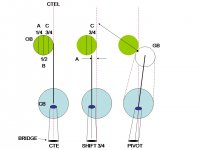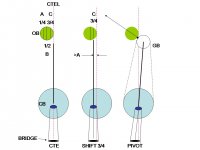I always liked this diagram, LAMas. This diagram actually demonstrates quite a bit. It demonstrates that equal-the-distance overlaps are cumbersome with discs of different sizes (visually). It also shows that "CB edge-to-target" references dictate the offset of the shooter's eyes from the CTEL (as diagrammed above) based on distance.
Spidy,
Thanks.
Some folks refuse to accept that shifts of the cue prepivot when aimed on a spot on the OB like 3/4/C will be different when the OB is farther away and appears smaller. Most of those think that all lines converge at angles and that all shifts to that spot are the same regardless of the relative size of the OB appearance.
I can use this non convergence to effect a smaller parallel shift from the CTEL and a bigger shift when the OB is closer and appears to be larger.
Please study the distance "A" in the first diagram and ">A" in the second.
This may help some folks.


This is why the CB doesn't go sailing past the OB on a single angle trajectory, but instead as the OB is farther away from the CB - the shift is smaller and the included trajectory angle is also smaller etc..
Last edited:
